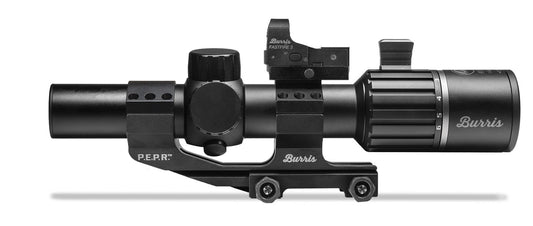

Burris Optics Rt6 1-6x24mm Ill Bar Ff3 Pepr delivers precision and clarity for both tactical shooting and outdoor competition. This first focal plane (FFP) scope features a versatile magnification range from 1x to 6x, allowing for fast target acquisition and adaptability in various shooting scenarios. Its illuminated reticle enhances visibility in low-light conditions, making it easier to spot targets at dawn or dusk.
Constructed with aircraft-grade aluminum, the Rt6 is built for durability, ensuring reliable performance even in harsh environments. This scope is also waterproof and fog-proof, providing peace of mind in unpredictable weather. User-friendly controls make it easy to adjust settings on the fly, making this scope an excellent choice for beginners and experienced shooters alike.
Features:
- FAST TARGET ACQUISITION for quick response in tactical situations.
- ENHANCED CLARITY for hunting at dawn and dusk, spotting targets easily.
- VERSATILE MAGNIFICATION from 1x to 6x for adaptability in various scenarios.
- ILLUMINATED RETICLE provides excellent visibility in low-light conditions.
- ROBUST CONSTRUCTION ensures durability even in harsh environments.
- WATERPROOF & FOG-PROOF performance for reliable use in any weather.
- USER-FRIENDLY CONTROLS for seamless adjustments on the fly.
- COMPATIBLE WITH MOUNTS for easy integration into your existing setup.
Technical Specifications Table
| Magnification | 1-6x |
|---|---|
| Lens Diameter | 24mm |
| Weight | 19.2 oz |
| Dimensions | 10.1 in x 2.5 in |
| Material | Aircraft-grade aluminum |
What’s in the Box?
- Lens covers
- Padded case
- Neck strap
Customer Reviews
“The Burris Optics Rt6 has transformed my shooting experience. Quick to adjust and incredibly clear!”
“Perfect for tactical shooting - the illuminated reticle is a game-changer!”
FAQ
How does the Burris Optics Rt6 perform in low light? The illuminated reticle provides excellent visibility even in challenging lighting conditions, making it a reliable choice for dusk hunting or early morning shoots.
Is it durable enough for outdoor use? Yes, this scope features robust construction that withstands harsh weather, ensuring it remains operational in a variety of conditions.
How does it compare with other rifle scopes? The Burris Optics Rt6 stands out due to its versatility and user-friendly features, making it suitable for both beginners and experienced marksmen alike.
Similar Models
Looking for more incredible optics? Explore our extensive Burris lineup, including models like the Burris XTR II for tactical precision and the Burris Fullfield E1 for versatile hunting. Discover our full collection for exceptional optics tailored to your adventures.
You May Also Like
Here’s some of our most similar products people are buying. Click to discover trending style.






